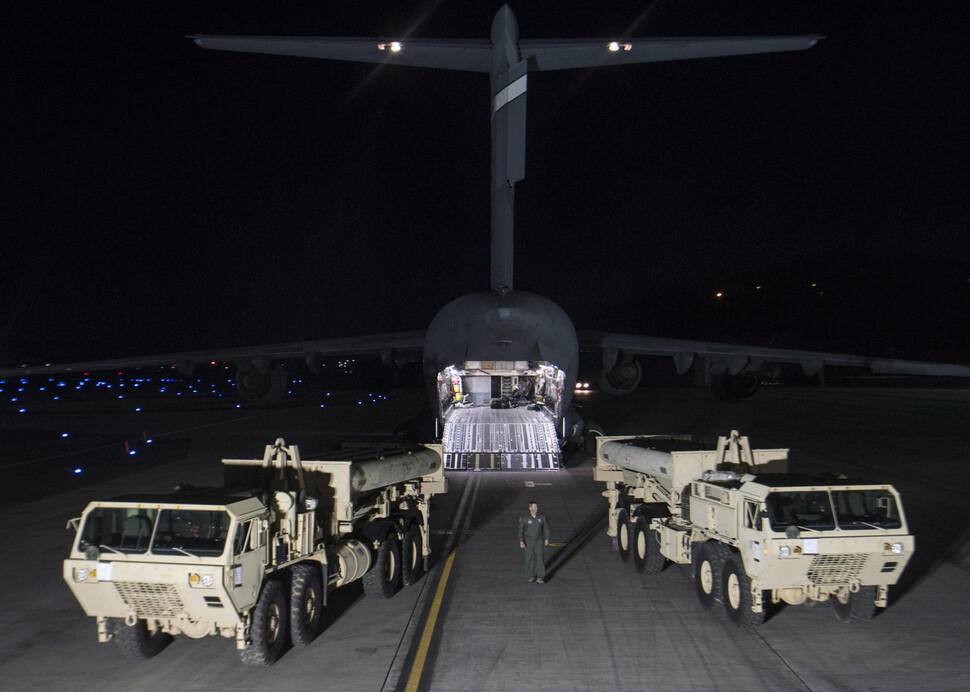hankyoreh
Links to other country sites 다른 나라 사이트 링크
[Editorial] Leave THAAD deployment for the next president to handle

On Apr. 16, a foreign policy advisor for the White House said that the questions of the timing of the THAAD missile defense system to the Korean Peninsula and when the system would come online were matters for the next South Korean president to decide.
Considering that the US has been rushing to deploy THAAD since bringing the THAAD launchers into South Korea in early March, this gave reason to think that the US was changing its plans. After a meeting with South Korea’s acting president Hwang Kyo-ahn the next day, US Vice President Mike Pence, who is currently visiting South Korea, said that THAAD is being deployed for the US-ROK alliance.
At first, the two remarks appear to be contradictory. But the advisor’s remarks were made to reporters inside Air Force Two, the plane bringing Pence to South Korea. The full text of the remarks clearly refers to South Korea’s “next president.” This was probably not a slip of the tongue. And Pence’s official statements the following day do not completely gainsay the White House advisor‘s remarks either.
It would be more rational to infer that since the US-China summit the US has taken steps to slow down the THAAD deployment to persuade China to put pressure on North Korea. During an interview on Apr. 16, US National Security Advisor HR McMaster said that a preemptive strike and other military actions were not an option for the North Korean issue, at least for the moment. That is one step back from the previous plan to consider “all the options” - including military action. This is all part of the same context. Since the US-China summit, China has been taking steps to control the North Korean nuclear issue, and it would be irrational for the US to accelerate the THAAD deployment despite these indications.
But without paying attention to these subtle changes in the atmosphere, the South Korean government is still parroting that the THAAD deployment is moving forward as planned and will be completed early. This illustrates the current administration’s impatience to deploy THAAD. It must not rob the next administration of its choice on the matter by rashly attempting to hasten the deployment. At any rate, it is physically impossible for a transitional government with just three weeks left in office to complete the THAAD deployment. Consequently, the natural thing is for the next administration to take the lead on the THAAD deployment after the presidential election. Since the next administration will launch immediately without the luxury of a transitional committee, each of the presidential candidates should start making diplomatic preparations while keeping an eye on the US and China‘s shifting stances on the Korean Peninsula.
Please direct questions or comments to [english@hani.co.kr]

Editorial・opinion
![[Column] Park Geun-hye déjà vu in Yoon Suk-yeol [Column] Park Geun-hye déjà vu in Yoon Suk-yeol](https://flexible.img.hani.co.kr/flexible/normal/500/300/imgdb/original/2024/0424/651713945113788.jpg) [Column] Park Geun-hye déjà vu in Yoon Suk-yeol
[Column] Park Geun-hye déjà vu in Yoon Suk-yeol![[Editorial] New weight of N. Korea’s nuclear threats makes dialogue all the more urgent [Editorial] New weight of N. Korea’s nuclear threats makes dialogue all the more urgent](https://flexible.img.hani.co.kr/flexible/normal/500/300/imgdb/original/2024/0424/7317139454662664.jpg) [Editorial] New weight of N. Korea’s nuclear threats makes dialogue all the more urgent
[Editorial] New weight of N. Korea’s nuclear threats makes dialogue all the more urgent- [Guest essay] The real reason Korea’s new right wants to dub Rhee a founding father
- [Column] ‘Choson’: Is it time we start referring to N. Korea in its own terms?
- [Editorial] Japan’s rewriting of history with Korea has gone too far
- [Column] The president’s questionable capacity for dialogue
- [Column] Are chaebol firms just pizza pies for families to divvy up as they please?
- [Column] Has Korea, too, crossed the Rubicon on China?
- [Correspondent’s column] In Japan’s alliance with US, echoes of its past alliances with UK
- [Editorial] Does Yoon think the Korean public is wrong?
Most viewed articles
- 1‘We must say no’: Seoul defense chief on Korean, USFK involvement in hypothetical Taiwan crisis
- 2N. Korean delegation’s trip to Iran shows how Pyongyang is leveraging ties with Moscow
- 3Amnesty notes ‘erosion’ of freedom of expression in Korea in annual human rights report
- 4[Column] Park Geun-hye déjà vu in Yoon Suk-yeol
- 5‘Weddingflation’ breaks the bank for Korean couples-to-be
- 6[Reportage] On US campuses, student risk arrest as they call for divestment from Israel
- 7[Editorial] New weight of N. Korea’s nuclear threats makes dialogue all the more urgent
- 8Why Korea shouldn’t welcome Japan’s newly beefed up defense cooperation with US
- 9[Guest essay] The real reason Korea’s new right wants to dub Rhee a founding father
- 10Will NewJeans end up collateral damage in internal feud at K-pop juggernaut Hybe?